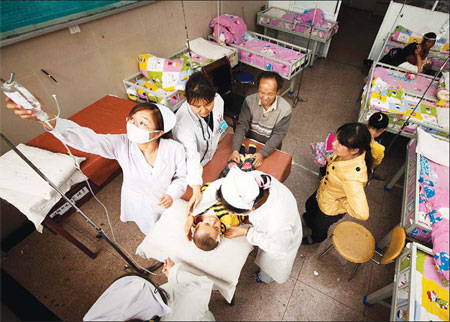Eye on the future
Updated: 2013-07-12 08:49
By Cecily Liu, Chen Yingqun and Ren Qi (China Daily)
|
|||||||||||
|
A doctor takes care of a young patient in rural China. Provided to China Daily |


Big pharma takes the road less traveled for big gains in China
China's dream of universal healthcare by 2020 is expected to create huge opportunities for foreign healthcare companies in rural China.
Though foreign healthcare companies are already providing training to rural doctors in China through their corporate social responsibility projects, many of them expect the informal collaboration to develop into actual revenue-sharing agreements in the future.
One such example is Denmark-headquartered pharmaceutical company Novo Nordisk, which entered the Chinese market in 1994, with a focus on diabetes treatment.
To expand its footprint in rural China, the company has invested heavily in training rural doctors on diabetes treatment, as rural areas do not currently receive much healthcare investment from the Chinese government, says Chen Jun, vice-president of marketing at Novo Nordisk China.
"In the past, many rural counties with a population of several hundred thousands did not have well-equipped hospitals or specialized doctors who had the capability to properly treat diabetes," Chen says.
"This means patients frequently had to travel a long way to cities to receive proper treatment, which was unsustainable for the management of the chronic disease due to the inconvenient distances and unaffordable costs due to the relatively low-income levels in rural areas."
To change this situation, Novo Nordisk's China team invested heavily in educating rural doctors on diabetes treatment so that patients receive treatment locally. Chen says this process also helps Novo Nordisk to promote its products in rural markets.
"We have a company culture where commercial activities are linked with corporate social responsibility, so our activities in rural China combine both goals," Chen says.
He says tackling diseases like diabetes is just as important in rural areas as urban areas, because urbanization has meant many rural residents traditionally involved in agricultural jobs are now moving to service-based jobs in nearby cities.
He says that though Novo Nordisk's activities in rural China may take some time to generate financial returns, it is a good sign for the future. The Swedish company believes that following this method will help it make considerable inroads into the overall Chinese market.
Chen's confidence in the ability of Chinese rural counties and towns to increase healthcare expenditure is understandable, considering that China has a goal of providing universal healthcare coverage by 2020.
Currently healthcare coverage is available to 95 percent of Chinese citizens, but many rural residents are still not covered, hence heavy investment in rural China is expected if universal coverage is to be achieved.
In 2012, China's Ministry of Health announced a new plan to increase the subsidy for each rural resident in areas with income levels under the national poverty line to 360 yuan ($57; 46 euros) from 200 yuan a month.
Rural residents living under the national poverty line will have 75 percent of their in-patient expenses reimbursed by 2015, according to the guidelines.
The ministry has also promised to implement more poverty-relief projects in remote mountainous regions as well as parts of Tibet and Xinjiang, among other poor areas.
"It is important for the Chinese government to ensure affordable and good quality healthcare in rural areas," says Zhang Binyun, deputy director of Fudan University's hospital management research institute.
"To improve rural healthcare, the government should invest more, improve rural healthcare practitioners' capabilities, and find a sustainable operation model for rural healthcare," Zhang says.
"All these elements should be implemented together. Investment in infrastructure should be accompanied by enhancement of skills and capabilities of doctors."
He says rural China has many opportunities for foreign investment, including the supply of affordable medical equipment, the supply of medicines and the training of rural doctors.
"The government should give more guidance for private sector investment, both in terms of commercial investment and charitable investment," Zhang says.
An example of a foreign company that has invested heavily in rural China for charitable causes is the Swiss pharmaceutical company Novartis, which has launched a project to educate schoolchildren about healthy living and train rural doctors from grassroots hospitals, so that they can better understand infectious diseases.
Known as Jian Kang Kuai Che (meaning Health Express), the project has extended basic health education to 690,000 schoolchildren and 33,000 adults and trained 800 infectious disease physicians, nurses and medical workers since its launch in the Xinjiang Uygur autonomous region in 2010.
Helen Chui, China president of Novartis, says the project aims to bring sustainable healthcare development to China, and her team wants to provide training to local children and improve doctors' capabilities in tackling diseases apart from just providing medicines as a cure.
"In the past decades, the Chinese government has made great efforts to improve healthcare for its citizens, but some challenges remain, especially in rural regions," Chui says.
"In rural areas, individuals do not know much about health and hygiene, and healthcare resources are also less developed than in other regions," she says.
According to Chui, Novartis' work in rural China aims to tackle these challenges, mainly by helping rural China build capabilities, so that the company's efforts can have an "enduring impact" for rural China in years to come.
The schoolchildren's training focuses on hygiene habits, and also covers basic lifesaving skills in cases such as fire and electric shocks. The training courses are designed with the hope that students will pass on their knowledge to their parents.
The doctors' training focuses on infectious diseases like hepatitis B treatment. According to the Ministry of Health, China has at least 20 million chronic hepatitis B patients, and the illness has become one of the top three infectious diseases in Xinjiang.
The training also encourages each physician to share with their patients information about the treatment of the chronic diseases like hepatitis B.
In 2012, Novartis signed an agreement with the Xinjiang government, and rolled out a three-year partnership to help Xinjiang improve its capacity for hypertension care and cardiovascular treatment.
According to Novartis, the Health Express project involves an investment of more than 10 million yuan every year.
German pharmaceutical company Bayer HealthCare and the Ministry of Health launched a training program in 2007 called Go West with the goal of improving medical infrastructure and standards of healthcare provision in rural regions, especially in West China.
The program offers training for rural physicians, and in each targeted region 600 hospitals are linked to a leading hospital that runs the training, according to Bayer.
The project has been successfully extended to 20 regions with 114 training courses completed by December 2012. It also provided professional training to more than 11,000 doctors and hospital executives, according to Bayer officials.
"We felt it was necessary to help the development of rural healthcare in China, given the inadequate infrastructure, doctors with less training, and low income of the population there," says Alok Kanti, managing director, Bayer HealthCare China.
"It is part of a long-term perspective. As a leading multinational pharmaceutical company, we would like to leverage our expertise and work with the government to develop China's healthcare infrastructure in these areas."
Kanti says that the Go West program focuses on common diseases in rural areas, frequently occurring, and difficult or complex diseases. It also provides training in county-level hospital management, doctor-patient relationships and other topics.
It is run in cooperation with medical colleges in China's rural areas, and full-time training programs, generally running for three months, covering topics including internal medicines, surgery, pediatrics, gynecology and medical technology, Kanti says.
(China Daily European Weekly 07/12/2013 page19)
Today's Top News
List of approved GM food clarified
ID checks for express deliveries in Guangdong
Govt to expand elderly care
University asks freshmen to sign suicide disclaimer
Tibet gears up for new climbing season
Media asked to promote Sino-Indian ties
Shots fired at Washington Navy Yard
Minimum growth rate set at 7%
Hot Topics
Lunar probe , China growth forecasts, Emission rules get tougher, China seen through 'colored lens', International board,
Editor's Picks

|

|

|

|

|

|






